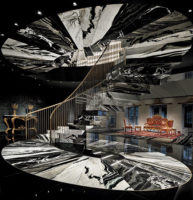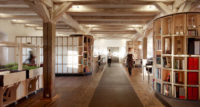Dolce&Gabbana’s palatial new store in Venice is among the first fruits of an alternative retail direction for the Italian fashion house, which is dropping the global identity of its outlets to give more latitude to individual locations and architects. The Venetian design, by Parisbased studio Carbondale, draws on both D&G’s heritage and the unique architecture of the city. “Venice is not a shopping destination, like Paris or Milan,” says Carbondale founder Eric Carlson. “It’s a cultural destination, and the idea was: make somewhere visitors put on their list of things to see.”
Additional Content:
Jump to credits & specifications
Arranged over two floors of a former bank on Calle Larga XXII Marzo, near Piazza San Marco, the 8,000-square-foot store comprises restored rooms in the older part of the building, which dates from the 1880s and faces the street, and equally opulent but more contemporary interiors created within a 20th-century addition behind.
Visitors entering a “welcome room” in the former banking hall are instantly immersed in authentic historic Venice. A restored coffered wooden ceiling with inlaid marquetry, and a polychromatic marble floor pile detail upon detail, while modern furnishings are designed to recede from view.
In the newer part of the building, Carbondale sought an interpretation of Venice that eschews both a pastiche of its glory years and also “the faded patina that we are attracted to in America,” says Carlson (who hails originally from Ann Arbor, Michigan). Domenico Dolce and Stefano Gabbana instead urged the architects to study the Luchino Visconti film The Leopard, set in 1860s Sicily, whose “colors are vibrant and alive.” The fashion designers were keen to represent Venetian architecture and aesthetics as living tradition, rather than as a museum piece. The fashion house founders compared two images of the city—an overblown Renaissance oil painting and a 1960s photograph of the Piazza San Marco, wet with reflections shimmering on the pavement. “Domenico pointed at the photo and said, ‘That’s our Venice,’ ” recalls Carlson. “Something crisp, something modern.”
The city’s form is consciously evoked in the plan of the store, which has been reconfigured to create an enfilade of rooms, like a palazzo. A narrow “canal room” links the welcome room to the jewelry room in the back, opening out at the sides to displays of clothing and shoes, and organizing circulation within the building as the waterways do in the city. Light from above is bounced around by a gold leaf–mosaic tiled wall and marble floor, in an echo of the reflected light that animates the city’s facades.
The most overt reference to Venetian architecture is in the jewelry room. Its walls are lined in deep-blue glass mosaic tiles inset with 24-carat gold stars—a color and motif borrowed from Saint Mark’s Basilica. Other allusions are subtler: stone and fabrics echo the bluegreen of the lagoon, while lacquered woodwork recalls the sleek water taxis that prowl the canals. Distinctively Venetian fixtures were fabricated by local craftsmen. Florid chandeliers came from the Seguso glass workshop on the island of Murano, along with sculptural tables and hanging rails.
Fine craftsmanship is also evident in the detailing of the junctions between materials. Brass fillets add articulation to wooden doorjambs and display units. Mirrored walls disappear into shadow gaps at the top but overhang marble baseboards, with light spilling from hidden sources behind.
Mirrors, polished marble, and shiny brass are consistent themes throughout the store but are handled in different ways, to denote distinct areas and to generate diverse spatial effects. Reflections double the apparent size of rooms or provide escapes for the eye, so that the rich intensity of displays and interior finishes never overwhelms. A blood-red mirrored ceiling is paired with pinkish marble walls and a cherry-red silk carpet to identify the women’s ready-to-wear clothing, while nearby menswear is designated by a blue-tinted mirror and green marble. Colors are matched in bespoke silk-velvet-covered chairs, resembling tailors’ pincushions, that are distributed liberally throughout the store, reflecting the fact that shoppers in the car-free city spend significant time on their feet.
It is this anticipation of customers’ needs and desires, more than the expensive materials, that creates a luxury retail experience, says Carlson. “It’s about how people move through the spaces and how we take care of them. When they try on clothes in front of the mirror, how do we make them feel beautiful?” To that end, Carbondale worked with London-based Mindseye to develop a mirror lighting system with four separate sources, which produces a crystal-clear reflection without glare.
Material opulence reaches its apogee on the upper floor, where formal wear is displayed. Wood inlays replace carpets on the marble floors, and gold abounds, woven into silk damask screens and embedded in Murano glass fixtures. Above the welcome room, a restored suite of 19th-century offices is a showcase for Venetian-themed couture dresses, displayed below original frescoed ceilings and new, wildly elaborate chandeliers.
Few visitors make it this far: the couture rooms are invitation-only, and the austere green marble stairway does not encourage casual browsers to venture upward. On the lower floor, however, shoppers and sightseers are made equally welcome. Dolce&Gabbana is “an Italian brand, not Parisian,” says Carlson. “It’s exclusive but with a heavy dose of inclusivity, which is reflected in the store design.” But while openness and navigability are important, says Carlson, “the ability to be lost is also a valid objective.” In the dreamlike spaces conjured by shimmering reflection, layered luxe materials, and exquisite detail, it is easily achieved.
CreditsArchitect: Carbondale — Eric Carlson, principal; Pierre Marescaux, associate; Jessica
Consultant: Mindseye (lighting design)
Client: Dolce&Gabbana — Daniele Fumagali, project director; Stella Marris Gonzales, Maja Filipovic Grcic, Manuel Chiragarula, Serhat Kelesoglu, project team
|
SpecificationsMosaics Friul Mosaic; Orsoni
Glass furnishings Seguso (chandeliers, display stands, mirror frames, doorknobs)
Furniture Battaglia
Carpet PBH
Textiles Bevilacqua (changing rooms); Rubelli (damask in formal-wear rooms) |















Post a comment to this article
Report Abusive Comment